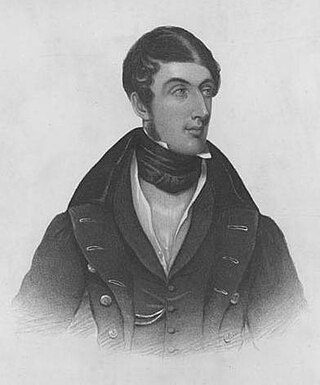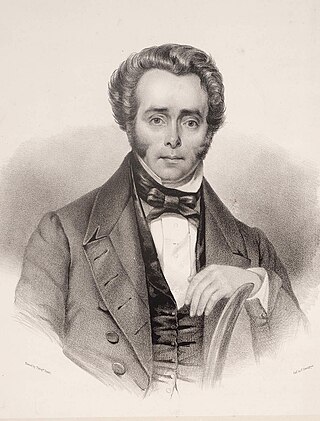
The Province of Canada was a British colony in British North America from 1841 to 1867. Its formation reflected recommendations made by John Lambton, 1st Earl of Durham, in the Report on the Affairs of British North America following the Rebellions of 1837–1838.

The Province of Upper Canada was a part of British Canada established in 1791 by the Kingdom of Great Britain, to govern the central third of the lands in British North America, formerly part of the Province of Quebec since 1763. Upper Canada included all of modern-day Southern Ontario and all those areas of Northern Ontario in the Pays d'en Haut which had formed part of New France, essentially the watersheds of the Ottawa River or Lakes Huron and Superior, excluding any lands within the watershed of Hudson Bay. The "upper" prefix in the name reflects its geographic position along the Great Lakes, mostly above the headwaters of the Saint Lawrence River, contrasted with Lower Canada to the northeast.

The Constitutional Act 1791 was an Act of the Parliament of Great Britain which was passed during the reign of George III. The act divided the old Province of Quebec into Lower Canada and Upper Canada, each with its own parliament and government. It repealed the Quebec Act 1774. The act remained in force until 1841, when it was largely repealed by the Union Act, 1840, which reunited the two provinces into the new Province of Canada. Some provisions relating to the clergy reserves remained in force. The remaining provisions of the act were repealed over time, with final repeal in 1966.

The Family Compact was a small closed group of men who exercised most of the political, economic and judicial power in Upper Canada from the 1810s to the 1840s. It was the Upper Canadian equivalent of the Château Clique in Lower Canada. It was noted for its conservatism and opposition to democracy.

Charles Poulett Thomson, 1st Baron Sydenham, was a British businessman, politician, diplomat and the first Governor General of the united Province of Canada.
Lower Canada Tories is a general name for individuals and parliamentary groups in Lower Canada, and later in the Province of Canada's division of Canada East, who supported the British connection, colonialism, and a strong colonial governor. They generally favoured assimilation of French-Canadians to British culture, laws, and the English language, and opposed democracy.
Clergy reserves were tracts of land in Upper Canada and Lower Canada reserved for the support of "Protestant clergy" by the Constitutional Act 1791. One-seventh of all surveyed Crown lands were set aside, totaling 2,395,687 acres (9,695 km2) and 934,052 acres (3,780 km2) respectively for each province, and provision was made to dedicate some of those reserved lands as glebe land in support of any parsonage or rectory that may be established by the Church of England. The provincial legislatures could vary or repeal these provisions, but royal assent could not be given before such passed bills having been laid before both houses of the British Parliament for at least thirty days.

John Strachan was a notable figure in Upper Canada, an "elite member" of the Family Compact, and the first Anglican Bishop of Toronto. He is best known as a political bishop who held many government positions and promoted education from common schools to helping to found the University of Toronto.

John Rolph was a Canadian physician, lawyer, and political figure. He was elected to the Parliament of Upper Canada in 1824 to represent Middlesex County and was considered the leader of the Reform faction in the 1820s. In 1837 he helped plan the Upper Canada Rebellion, but acted as the government's emissary to negotiate a truce once the rebellion began. In the 1850s he was elected to the newly-formed Parliament of the Province of Canada, representing Norfolk County, and was appointed as Minister of Crown Lands and Minister of Agriculture. He founded several medical schools throughout his life, including the Rolph School, and incorporated new teaching techniques and medical practices into his lectures. His actions against rival medical schools decreased public confidence in the ability of medical professionals to regulate themselves.
The Legislative Council of the Province of Canada was the upper house for the Province of Canada, which consisted of the former provinces of Lower Canada, then known as Canada East and later the province of Quebec, and Upper Canada, then known as Canada West and later the province of Ontario. It was created by The Union Act of 1840. With the lower house, the Legislative Assembly of the Province of Canada, the two houses constituted the Parliament of the Province of Canada.
The Ecclesiastical Commissioners were, in England and Wales, a body corporate, whose full title was Ecclesiastical and Church Estates Commissioners for England. The commissioners were authorised to determine the distribution of revenues of the Church of England, and they made extensive changes in how revenues were distributed. The modern successor body thereof are the Church Commissioners.
The Clergy Corporation, or the Clergy Reserve Corporation of Upper Canada, existed to oversee, manage and lease the Clergy reserves of Upper Canada, a large amount of land in Upper Canada that had been put aside for the Anglican and later Protestant churches. The main operations of the corporation were to collect rents on these lands, receive petitions, answer inquiries and settle all disputes arising from the clergy land.

James Hervey Price was a Canadian attorney and political figure in Canada West. He was born and grew up in Cumberland, United Kingdom, and studied law at Doctors' Commons. He moved to Upper Canada in 1828 and became an attorney in 1833. He was appointed the city of Toronto's first city clerk in 1834 and the following year built a house north of Toronto that he named Castlefield. In 1836 he was elected as a city councillor for St. David's Ward in Toronto but was defeated the following year. Although he considered himself a Reformer, he did not participate in the Upper Canada Rebellion. In 1841 he was elected to the first Parliament of the Province of Canada, representing the 1st riding of York as a Reformer. He served as the commissioner of Crown lands from 1848 to 1851 when he was defeated in his reelection campaign for his seat in the Parliament. He withdrew from politics and worked as an attorney until his retirement in 1857. In 1860 he returned to Britain to Bath, and died in Shirley, Hampshire, in 1882.
John Robinson Hamilton, QC was a lawyer and political figure in Lower Canada and then the Province of Canada. He represented the electoral district of Bonaventure 1832 to 1834 in the Legislative Assembly of Lower Canada. Following the creation of the Province of Canada, he again represented Bonaventure from 1841 to 1844 in the Legislative Assembly of the Province of Canada. He opposed the union of Lower Canada and Upper Canada into the Province of Canada, and supported the reform movement, which favoured responsible government.
John Yule was a businessman, seigneur and political figure in Canada East in the Province of Canada. He lived all his life in the town of Chambly, south of Montreal. He had considerable business success providing supplies to the British Army garrison at Fort Chambly, as well as a variety of business activities in the Chambly area. He was responsible for the construction of the first bridge at Chambly across the River Richelieu. Yule represented the Chambly riding in the Legislative Assembly of the Province of Canada from 1841 to 1843, as a unionist and Tory.
Bellechasse was an electoral district of the Legislative Assembly of the Parliament of the Province of Canada, in Canada East. It was created by the Union Act, 1840 in 1841, based on the previous electoral district of the same name for the Legislative Assembly of Lower Canada. It was located in the current Chaudière-Appalaches area.

The Parliament of the Province of Canada was the legislature for the Province of Canada, made up of the two regions of Canada West and Canada East.
Beauharnois was an electoral district of the Legislative Assembly of the Parliament of the Province of Canada, in Canada East, in a rural area south of Montreal. It was created for the first Parliament in 1841 and was based on the previous electoral district of the same name for the Legislative Assembly of Lower Canada. It was represented by one member in the Legislative Assembly.
Two Mountains was an electoral district of the Legislative Assembly of the Province of Canada, Canada East, in a rural area north-west of Montreal. It was created in 1841, based on the previous electoral district of the same name for the Legislative Assembly of Lower Canada.
Nicolet was an electoral district of the Legislative Assembly of the Parliament of the Province of Canada, in Canada East, centred on the town of Nicolet. It was created in 1841 and was based on the previous electoral district of the same name for the Legislative Assembly of Lower Canada. It was represented by one member in the Legislative Assembly.








